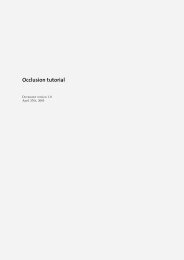mental ray Architectural and Design Visualization Shader Library
mental ray Architectural and Design Visualization Shader Library
mental ray Architectural and Design Visualization Shader Library
You also want an ePaper? Increase the reach of your titles
YUMPU automatically turns print PDFs into web optimized ePapers that Google loves.
32 2 <strong>Architectural</strong> Material2.5.8 Advanced Rendering Options2.5.8.1 Reflection Optimization SettingsThese parameters define some performance boosting options for reflections.refl falloff dist allows limiting reflections to a certain distance, which both speeds uprendering as well as avoiding pulling in distant objects into extremely glossy reflections.If refl falloff color is enabled <strong>and</strong> used, reflections will fade to this color. If it is not enabled,reflections will fade to the environment color. The former tends to be more useful for indoorscenes, the latter for outdoor scenes.Full reflections (left), fading over 100mm (center) or 25mm (right)Each material can locally set a maximum trace depth using the refl depth parameter. Whenthis trace depth is reached the material will behave as if the refl hl only switch was enabled,i.e. only show highlights <strong>and</strong> “emulated” reflections. If refl depth is zero, the global tracedepth is used.refl cutoff is a threshold at which reflections are rejected (not traced). It’s a relative value,i.e. the default of 0.01 means that <strong>ray</strong>s that contribute less than 1% to the final pixel areignored.2.5.8.2 Refraction Optimization SettingsThe optimization settings for refractions (transparency) are nearly identical to those forreflections. The exception is that of refr falloff color which behaves differently.
















